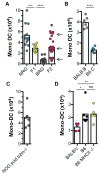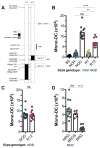Donor SIRPα polymorphism modulates the innate immune response to allogeneic grafts
- PMID: 28783664
- PMCID: PMC5653256
- DOI: 10.1126/sciimmunol.aam6202
Donor SIRPα polymorphism modulates the innate immune response to allogeneic grafts
Abstract
Mice devoid of T, B, and natural killer (NK) cells distinguish between self and allogeneic nonself despite the absence of an adaptive immune system. When challenged with an allograft, they mount an innate response characterized by accumulation of mature, monocyte-derived dendritic cells (DCs) that produce interleukin-12 and present antigen to T cells. However, the molecular mechanisms by which the innate immune system detects allogeneic nonself to generate these DCs are not known. To address this question, we studied the innate response of Rag2-/- γc-/- mice, which lack T, B, and NK cells, to grafts from allogeneic donors. By positional cloning, we identified that donor polymorphism in the gene encoding signal regulatory protein α (SIRPα) is a key modulator of the recipient's innate allorecognition response. Donors that differed from the recipient in one or both Sirpa alleles elicited an innate alloresponse. The response was mediated by binding of donor SIRPα to recipient CD47 and was modulated by the strength of the SIRPα-CD47 interaction. Therefore, sensing SIRPα polymorphism by CD47 provides a molecular mechanism by which the innate immune system distinguishes between self and allogeneic nonself independently of T, B, and NK cells.
Copyright © 2017 The Authors, some rights reserved; exclusive licensee American Association for the Advancement of Science. No claim to original U.S. Government Works.
Conflict of interest statement
Figures







Comment in
-
Donor SIRP-α polymorphisms: widening the innate-to-adaptive continuum in allograft rejection.Kidney Int. 2017 Dec;92(6):1305-1308. doi: 10.1016/j.kint.2017.10.006. Kidney Int. 2017. PMID: 29153131
References
Grants and funding
LinkOut - more resources
Full Text Sources
Other Literature Sources
Molecular Biology Databases
Research Materials

